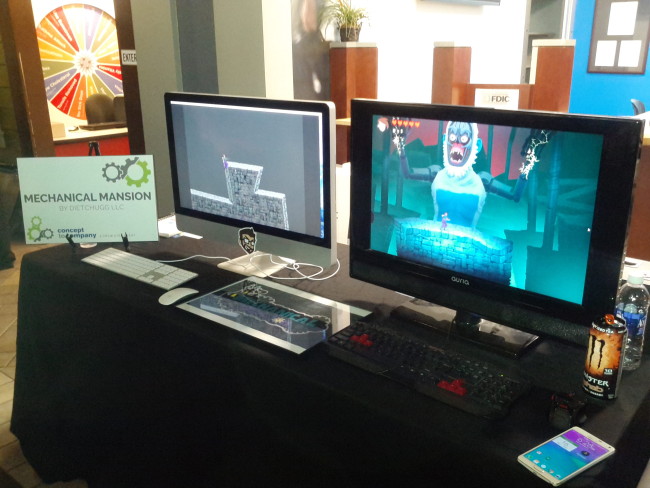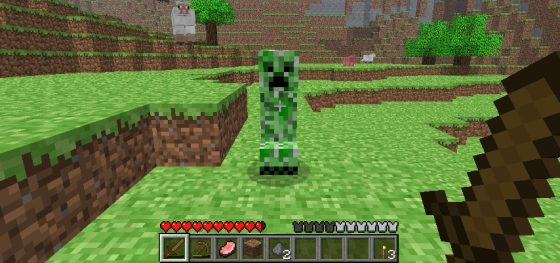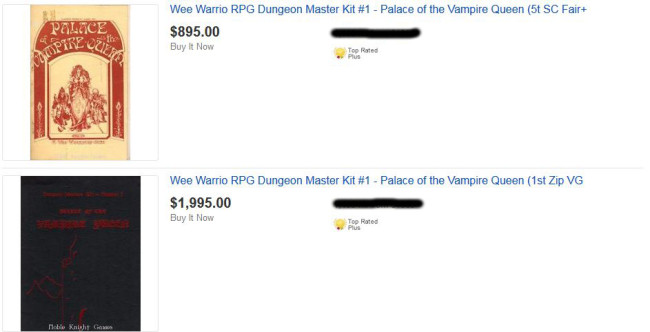Heading Off to Comic Con!!!!
Posted by Rampant Coyote on September 23, 2015
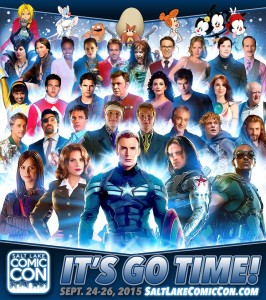 I’m going to be at Salt Lake Comic Con this weekend – from tomorrow (the 24th) through Saturday the 26th. It’ll be a good time.
I’m going to be at Salt Lake Comic Con this weekend – from tomorrow (the 24th) through Saturday the 26th. It’ll be a good time.
I will be found (much of the time) at the Xchyler Publishing author’s table at BK17. We’ll be next to Curiosity Quills and Space Balrogs. Which means fun. If you are going to be there, come visit us and say hi!
We’ll have tons of books, including Terra Mechanica and Mechanized Masterpieces 2: An American Anthology, with several authors on-hand to deface them with signatures if that’s your preference. 🙂 Sadly, the new anthology Beyond the Wail won’t be out for a few weeks. We’re still putting the finishing touches on that one.
No matter what, it’s going to be a fun three days.
Filed Under: Books, Events - Comments: Comments are off for this article
Game Dev Tools Bundles!
Posted by Rampant Coyote on September 22, 2015
So Humble Bundle got together with GameMaker to create a bundle that includes some games that were popular / successful make with GameMaker, including *source code*, and the Pro version of GameMaker Studio, and the exporter for Android. By the sounds of how YoYo Games’ website is now getting HAMMERED with new registrations, I’d guess that’s a pretty popular bundle. (Over 64,000 copies of the bundle in one form or another have been sold so far, so… yeah, probably).
There’s only a couple of days left on this bundle, so act now if you are interested… It may be a pain in the butt to register your account for a while, but it should eventually work:
Humble Weekly Bundle: Play and Create Bundle
If GameMaker Studio isn’t your stile, BundleStars has a bundle emphasizing RPG Maker VX Ace and GameGuru. It has about six days left on this sale, but $8.50 gets you a crapload of game development software and expansions.
Game Makers Mega Bundle at BundleStars
Of course, the indie level of Unity is still free.
But man. What an incredible time to be a game developer, huh? Powerful tools, use for several commercially successful products, tossed at you for peanuts. 🙂 Good stuff.
UPDATE: The YoYo Games website is currently down for maintenance because of the traffic from the bundle. They are trying to fix things. That might mean you don’t get to download GameMaker Studio immediately (I couldn’t register the Android exporter last night, myself), but the bundle and the codes should be fine once things get stabilized.
Filed Under: Game Development - Comments: Comments are off for this article
Funding: Legacy of the Elder Star
Posted by Rampant Coyote on September 21, 2015
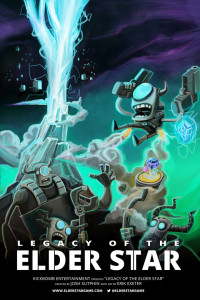 Since I was a child of the arcade era, shoot-em-ups (or “shmups”) hold a special place in my heart. Galaga remains high on my list of favorite games of all time, and a shining example of excellence in game design. I’m not as devoted to them as some other genres, however, so to this day I still don’t consider myself very good at them. But they are perfect for a quick 10 or 15 minute stress-relieving break.
Since I was a child of the arcade era, shoot-em-ups (or “shmups”) hold a special place in my heart. Galaga remains high on my list of favorite games of all time, and a shining example of excellence in game design. I’m not as devoted to them as some other genres, however, so to this day I still don’t consider myself very good at them. But they are perfect for a quick 10 or 15 minute stress-relieving break.
“Bullet Hell Shooters” are a subclass of the genre where the player faces an overwhelming barrage of enemy projectiles. Frequently, towards the end levels, the “bullets” really are the level, forcing the player to create and navigate narrow free corridors within a wall of enemy shots. It’s crazy. It looks incredibly cool, though, and is something I like the idea of playing. But in practice… well, I suck.
A friend of mine, Josh Sutphin of Kickbomb Entertainment, had a similar problem a few years ago. He loved these really crazy modern shmups like Jamestown and Cave’s shooters (like Mushihime-sama Futari), but the really crazy-fun looking games not only had a steep learning curve, but they were intimidating to players. They are the kinds of games people would rather watch than play. Strong play tended to depend on memorization of levels and patterns, which can take a long time.
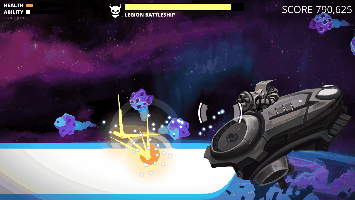 After spending a lot of time playing these games and really getting to understand their appeal and their challenges, he set forth making a high-powered shoot-em-up of his own, but one that (he hopes) can both appeal to veterans of the genre but also provide a good introduction for players like me who… well, suck at them, and get tired of getting stomped to the ground quite so quickly.
After spending a lot of time playing these games and really getting to understand their appeal and their challenges, he set forth making a high-powered shoot-em-up of his own, but one that (he hopes) can both appeal to veterans of the genre but also provide a good introduction for players like me who… well, suck at them, and get tired of getting stomped to the ground quite so quickly.
His answer is called Legacy of the Elder Star, and it’s pretty awesome. It’s still in development, although at this point the core gameplay is all there – it’s mainly expanding the content. He just started a Kickstarter campaign, and I wanted to share it with folks here:
Kickstarter: Legacy of the Elder Star
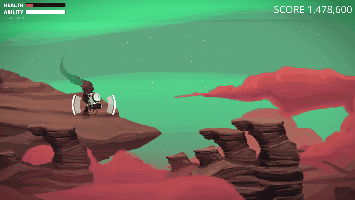 Now Josh is an experienced game developer who has worked in AAA before (including working on the direct and a spiritual descendant of one of my first commercial games, Warhawk). He’s a friend, and he’s done a lot to support the indie community here in Utah over the last year or so. He’s a stand-up guy who I personally trust to get the job done. Which all means that I’d be happy to throw some money at him as a favor even if I didn’t care about the game.
Now Josh is an experienced game developer who has worked in AAA before (including working on the direct and a spiritual descendant of one of my first commercial games, Warhawk). He’s a friend, and he’s done a lot to support the indie community here in Utah over the last year or so. He’s a stand-up guy who I personally trust to get the job done. Which all means that I’d be happy to throw some money at him as a favor even if I didn’t care about the game.
But in this case, I think the game is awesome, and I’m really excited to see it reach its potential. I also like that it’s leading the charge as a PC (Windows / Mac / Linux) game, specifically for that platform, with some really cool direct mouse control & stuff like that. While I think it might be awesome to see it make its way to consoles in the future, I love it when indies embrace the PC. I also like how the more dynamic approach to enemies mean there is (of necessity) less emphasis on anticipating and memorizing the level and more on dynamically reacting to the enemies and their firing patterns. I’ve played several demos of the game during its evolution, so I do feel Kickbomb is doing a great job of executing on the concept. Yes, the game can still kick my butt pretty well, but I never feel like it’s beyond me. Even those #%^$ seekers don’t seem overwhelming, just challenging.
(The animated gifs are from my own playthroughs… from a nice tool built into the game, even if the gifs run a bit slower than the real gameplay.)
That’s where I’m coming from, anyway. You’ve got a different story, and don’t personally know these guys. I’d just like to invite you to check out the campaign and see if that’s something you’d personally be interested in and feel comfortable with contributing to. I’ll let Josh and Erik (the artist) pitch the game to you from here. Check out the campaign, and their website, and see what you think.
Good luck and have fun!
Filed Under: Game Announcements, Indie Evangelism - Comments: Read the First Comment
Utah Game Wars 2015
Posted by Rampant Coyote on September 18, 2015
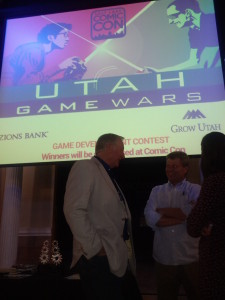 The awards for Utah Game Wars 2015 was Wednesday night. This is an annual event that I haven’t attended or participated in before now.
The awards for Utah Game Wars 2015 was Wednesday night. This is an annual event that I haven’t attended or participated in before now.
Half of the event was private for the judges and the finalists, and then they let the rest of us in for food, games, and the award ceremony. The game devs got to do their pitch to the judges. The judging was partly about the games (although that was more for the audience choice award), but was more about the companies involved: Who needed the investment, who was really innovating, who was poised to grow. The winner and two runners-up of the eight finalists would be given a cash prize, and a lot of services from local companies representing legal, business, and health care services.
The eight finalists were:
HealthX, a game controlled by eye movement for diagnosis and treatment of Lazy Eye
Crashnauts, a multiplayer 2D “arena” game
Super Dragon Heroes – a multiplayer battle arena game on mobile
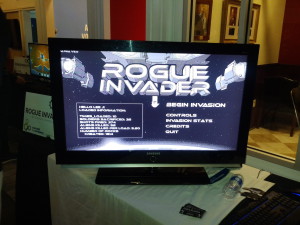 Rogue Invader – A procedurally generated side-scrolling game with a really cool old-school black & white / dithered look. Seeing 3D graphics in action rendered as if they were black-and-white pixel art is something else.
Rogue Invader – A procedurally generated side-scrolling game with a really cool old-school black & white / dithered look. Seeing 3D graphics in action rendered as if they were black-and-white pixel art is something else.
Mechanical Mansion – really a show-piece for a really cool platformer-base Unity toolkit. The toolkit makes things easy enough that this game was able to be created within about 2 weeks.
Together: Amna & Saif – a 2-player cooperative puzzle game that requires two players playing cooperatively in order to complete the levels.
Momentum – an awesome 3D marble maze game
Reign of Darkness – a 3D free-to-play MMORPG
It was pretty exciting seeing what small gaming companies are doing here in Utah. The competition was for small companies – independent, but not what we’d necessarily consider “indie” – to compete with more of an entrepreneurial emphasis. As explained prior to the audience voting and the awards, what they are looking for is companies poised to grow – to build the local economy.
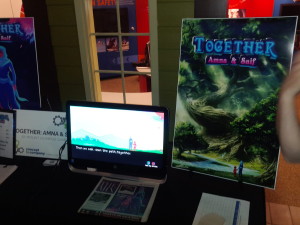 Super Dragon Heroes ended up the winner for the evening, with Together: Amna and Saif and HealthX as runners-up. All three games will be sharing booth space at Salt Lake Comic Con in a week. (And there I was, a year ago, next-door neighbors with Together: Amna and Saif at Comic Con last year! 😉 )
Super Dragon Heroes ended up the winner for the evening, with Together: Amna and Saif and HealthX as runners-up. All three games will be sharing booth space at Salt Lake Comic Con in a week. (And there I was, a year ago, next-door neighbors with Together: Amna and Saif at Comic Con last year! 😉 )
One thing that was interesting to me was that I was only previously familiar with about half of the games being presented. The others I didn’t know existed. We keep discovering just how many local game developers there are – in many cases laboring in their basements or college labs – that are not really connected and don’t know what resources are available. We’re trying to improve this, but it’s still tough getting the word out to everyone.
Anyway, it was very cool to see the local business community supporting game developers like this. I’m not exactly sure how many years this has been going on, but it’s been at least three. I think they mentioned six years. Anyway, go Utah! Hopefully I’ll be able to attend again next year. Many congrats to the finalists, the runners up, and React Games for winning the grand prize!
Filed Under: Events - Comments: Comments are off for this article
On Ego Trips and Publishing Pace
Posted by Rampant Coyote on September 17, 2015
Since I’m now doing double-duty as both a writer and a game developer (gee, anything else I should acquire as a major hobby / side occupation? Maybe get a law degree?), it’s been interesting having a foot in both camps and watching the parallels. Both have enjoyed an indie revolution, which has caused a good deal of turmoil and glutted the field – mostly with crap, but that’s Sturgeon’s Law at work. And besides, like the saying kinda goes, one man’s piece of crap that should never have been released is another man’s diamond in the rough, or something…
Now I fully admit I’m a lot slower at both than I would like to be. I’m working on it. Writing surprised me with how slow I am. Actually, game development is the same. In my mind, I’m a lot faster. Probably because when things are going really well and I’m really making tons of progress, time disappears for me and I think I’ve only been at it an hour when closer to three have passed by.
But if I could write four novels a year, or release two RPGs a year, or some combination of this (2 novels and 1 game?), I totally would. I aspire to this. Because my experience as an indie and my work with other indies (both in games and in print) who I consider to be successful leads me to believe that the “secret to success” in both fields (in most creative fields for that matter) is pretty boring:
- Predictable and reasonably frequent releases
- Sufficient quality
- Targeted to an appropriate market
Of course, there are tons of variables that change constantly in there. But ultimately, it comes down to getting a chance up to bat as frequently as possible, and being good enough that you can usually score a base hit even if luck doesn’t favor you with a home run.
And of course, everyone can name a handful of people who bucked this process and succeeded extremely well by most definitions of “success.” It happens. And we can all define “success” however we want.
However, a recent article in the Huffington Post which I am declining to link to in order to avoid this kind of linkbait trolling in the future made a case that nobody should be very prolific, and that if you were writing more than one book a year (yes, the author’s arbitrary cap on frequency) then you couldn’t possibly be creating a quality masterpiece like you should be, implying strongly that anybody publishing more frequently than that has sold their soul to be a crappy hack writer. She also stated quite firmly that indie was a second-class tier of far lower worth than getting released by the major publishers.
Of course, she herself has only one book released which she self-published, excusing herself because she did it after a very long period of painstaking development and was ready to unleash her masterpiece on the world, and hadn’t yet shopped it around to publishers (who, I guess, would have no doubt been chomping at the bit to represent her masterpiece if only she’d given them a chance).
This article has been thoroughly torn apart by a large number of authors whom I would consider quite successful. I’m sure some rich and successful author has risen to her defense at some point, but that could just be a ploy to keep the competition down. (Some interesting examples can be found here, here, and my favorite here).
I agree with many of the arguments against this. What makes one per year an arbitrary “reasonable” value anyway? And who is the arbiter of “great?” I really don’t know. Many of the classics we now revere were written by “hacks” who just kept cranking things out at a really amazing rate. With the exception of maybe Shakespeare, only a fraction of their work is really remembered and so honored, so none of ’em were batting 1.000 according to modern critics.
There’s another saying we had back at SingleTrac, which came out effectively as, “That’s why sequels exist.” In game development, the final product is NEVER as awesome as we imagined it. In hindsight, once it’s really too late to rip everything apart and start over, we know the things we should have done, and how we could have done it better. We learn with every game. I was on a panel with Steve Taylor of NinjaBee at the Salt Lake Gaming Con a few weeks ago, and he said about the same thing. I don’t remember exactly what he said, but it was along the lines of, “I’ve developed and shipped over thirty games in my career, and I feel like I’m just now starting to figure out how to make games.”
The thing is – there’s no such thing as perfect. There’s no perfect book, there’s no perfect game. And echoing Steve’s statement, I feel like in both writing and game development, the more that I learn, the more I learn how much I still need to learn. There’s this really weird view that we can take our first pass on something, stick it in a rock tumbler called “workshops” and just keep going and going and going, and eventually it’s going to come out a polished gem. It’ll be more polished, but if it wasn’t a gem going in, it won’t magically transform when it comes out. Most of the time, we just need to take what we’ve learned and move on to the next project… with better ideas, better skills.
And yes, better ideas come. It seems that when you are a newbie in a creative field, you come in with some tender, awesome, wonderful ideas that may actually be pretty awesome and wonderful, but you hold onto them jealously as if that’s all you’ve been allotted in life and you don’t want to waste them. I suppose we do go through dry periods sometimes, but most of the people I know in creative industries have the opposite problem – they’ve got more things on their back-burners than they could finish in a lifetime.
But on a completely different tack… why are you creating this thing? Who are you creating it for? The implication by the article seems to be that you are creating it for yourself. Anyone else who happens to understand your creative genius can therefore bask in your glow. While I would agree that you are your own audience and you should make the things that make you happy… write the books you’d want to read, write the games you want to play… that’s a fundamentally self-centered viewpoint. It’s about serving our own ego. And while that’s not a terrible thing, if that’s your highest and noblest goal, IMO you are shooting pretty low.
In my view, we’re actually serving other people. Our audience. That is what we SHOULD be about. Worry about their happiness, and let our own take care of itself, I guess. I remember listening to an interview with John (“Cougar”) Mellencamp, and he was asked “Do you ever get tired of playing the same old songs in concert? Don’t you wish there was more demand for your newer music?” While I was never a big fan of his music, my respect for him as an artist went way up when I heard his reply. He said, “No, because I’m only here because of them. I’m an entertainer, and they are paying me to play what they want to hear.”
You hear a bit about games and software turning into a bit more of a service industry, but most of the time when people are talking about that, they are really only talking about ways to maximize their revenue generation. But I think to a large degree, all creative “industries” are exactly about that. So really, as artists or “creative workers,” shouldn’t our job really be about creating things for our audience in whatever quantity AND quality makes them happy? If one comes at the expense of the other (which is eventually true, but the relationship is a lot more complicated up until we hit a really high threshold), then we may have to strike a balance that pleases our audience.
If your average gamer / reader is like me… they really want both.
Filed Under: Books, Production - Comments: 7 Comments to Read
Happy Birthday Ultima IV
Posted by Rampant Coyote on September 16, 2015
 Ultima IV was released 30 years ago today.
Ultima IV was released 30 years ago today.
How can it be that old? How can *I* be this old?
I didn’t finish it the first time I played it (on my Commodore 64). I had, you know, stuff.
Eight years later, I was in college and injured. I spent the next day (Friday) laid up and unable to walk very well. I’d been playing Ultima 7: The Black Gate, and since I wasn’t going anywhere, I decided to focus the day on finishing the game. I did, by mid-afternoon. I guess I was closer to the end than I thought. It was kind of a magical experience. When it was over, the Black Gate destroyed and the Guardian blocked from entering Britannia, I didn’t know what to do with the rest of the evening, and I seriously wanted to keep playing.
A neighbor had recently picked up the “Complete” Ultima collection for DOS, and so I called him up and asked to borrow one of the disks. I chose Ultima IV. I had forgotten a lot about it. For the first hour, I was really struggling to deal with the primitive graphics and interface (and today, the same happens when I play Ultima VII!). In another hour, I was doing okay, and starting to get into the swing of things. By the third hour, I was lost.
If you play it today (free on GOG.COM!), you’ll note that the much-discussed virtue system is really pretty straightforward and mechanical, particularly once you figure things out. You can even visit Hawkwind and see how you are progressing in your progress to embody the virtues. While the game doesn’t spell out the exact details of how many points you move up or down, it’s reasonably transparent, and really kind of expects you to game it. Like the choices at the beginning of this and the next two games in the series, it’s not about attaining perfection, but achieving a personal balance.
What it did was add another dimension to the RPG, one that was on equal footing with the traditional power-gaining race. This was a huge step, and while other games have turned this into much more detailed and complex alignment or faction systems, the fact that it was a primary game mechanic changed the feel of the game in a way rarely experienced in today’s games. In my view, it still holds up today, although you do need a bit of patience for such a retro-game.
I love Ultima IV, but man. Thirty years? Really? Sheesh!
Filed Under: Retro - Comments: 4 Comments to Read
Summoning the Imagination in Games
Posted by Rampant Coyote on September 15, 2015
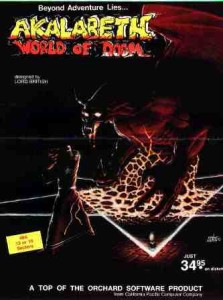 A friend of mine in Junior High School showed me an ad in his computer magazine for Akalabeth: World of Doom. It pictured some kind of wizard near a glowing pentagram with a demon or lava-creature rising out of the earth at the center.
A friend of mine in Junior High School showed me an ad in his computer magazine for Akalabeth: World of Doom. It pictured some kind of wizard near a glowing pentagram with a demon or lava-creature rising out of the earth at the center.
By the standards of the time, it was a pretty cool image. I instantly wanted the game, but it was an Apple II exclusive and I couldn’t have afforded it even if I had an Apple II. Not that I really wanted a game where you summon demons (or have demon summoning go awry) or anything like that, but the image suggested fantasy drama and detail that I really wanted to see. There was a story there behind that image, and I wanted to know what the story was. Who was that sorcerer? Why was he trying to summon such a horrible demon? Why was the world doomed? Or was it just filled with doom?
I never did get to play the game… at least not until decades later (thank you, GOG.COM) Sadly, the actual game had zero to do with the ad, as far as I could tell. Mainly the game was wandering around the world starving to death doing assassination missions for the king with clunky line graphics.
It was simply an inspiring ad. I got to imagine all kinds of amazing things in the game. The words “Beyond Adventure” channeled up thoughts of the two text-based adventure games I was familiar with at the time (Zork and Colossal Cave), and of course there was plenty of room for deep, dramatic, detailed stories in that medium. With no screenshots, I could only imagine the kind of awesome game my friends with Apple II’s had access to, even recognizing some of the technological limitations of the era.
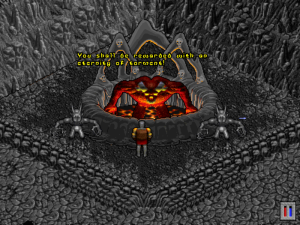 Many years later, designer Richard Garriott made follow-ups with far greater depth, story, interesting characters, and worlds facing certain doom. There was even summoning of nasty beings, too. Sorta like he was trying to live up to that old ad.
Many years later, designer Richard Garriott made follow-ups with far greater depth, story, interesting characters, and worlds facing certain doom. There was even summoning of nasty beings, too. Sorta like he was trying to live up to that old ad.
As amazing as the Ultima games were, I think my imagination was a little better. Mostly.
Okay, the destroying of the Black Gate at the end of Ultima 7 was something of a riff on this theme, and it was pretty dang epic for its time, I’ve gotta admit.
I think some of the nostalgia older gamers feel for the classic games comes not from a belief that the games were literally superior to modern counterparts (although sometimes that’s the case), but more in that the older games – out of necessity – did a better job of invoking the imagination. The graphics were clunky, the text was limited, the UI was painful… but somehow we were more involved and engaged, and the world was more real to us than the most amazing graphical available today.
Scott McCloud explains this phenomenon in the book Understanding Comics. The more abstract images invite us to project our own thoughts and ideas into the scene. In some ways, this makes for a far more powerful message, simply because we have invested meaning into it ourselves.
I was reminded of this recently when I read Dungeon Hacks:
To their astonishment, the imaginations of the players filled in the blanks left by inadequate technology. “People would invent meaning,” Toy remembered. “They would place themselves in this situation and their creativity would express itself. They made the world more interesting and beautiful. So even though the thing I created wasn’t beautiful, people would color it with their own imagination, the same way you do when playing a text adventure. I’d listen to someone trying to explain how to play the game to someone else, and they’d start talking about something that was completely ridiculous and made up. They’d say, ‘this is how this particular monster thinks.’ And I’m thinking, That monster? He’s one of the non-thinking monsters!”
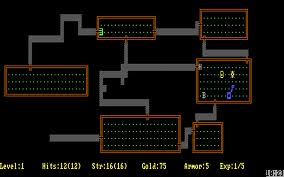 Not that I’m a big proponent of going back to ASCII graphics, mind you. After all, this post started with me talking about what I thought was a really cool picture when I was 12 or 13 years old. Although I did get pulled into Moria in a similar way once upon a time. But really, it’s about the world’s presentation being inviting enough to pull a player in (which varies wildly from player to player), and also inviting the player to expand on their own imaginary model of the world.
Not that I’m a big proponent of going back to ASCII graphics, mind you. After all, this post started with me talking about what I thought was a really cool picture when I was 12 or 13 years old. Although I did get pulled into Moria in a similar way once upon a time. But really, it’s about the world’s presentation being inviting enough to pull a player in (which varies wildly from player to player), and also inviting the player to expand on their own imaginary model of the world.
Here’s another excerpt from the book:
“We got drawn into the world, and you would imagine yourself in the world. You’d see a letter ‘T’ on the screen, and it would startle you because you knew it was a troll.”
Nowadays, the focus is heavily on more realistic graphics, and cut-scenes to force the player’s attention on heavily scripted sequences. Is this an artifact of a bygone era, or is it still possible that abstract graphics have the power to cause this emotional reaction in modern players?
For that, I have this answer:
All Minecraft players know, hate, and love the Creeper. He’s become the mascot for the game. And while I’ve seen attempts to render it more realistically, they’ve always failed to improve on this simple, blocky, texelated model. He’s scarier when the details are left to the imagination.
It’s a fine line. On the one hand, I love the exciting modern detail. But artistically, I’d like to leave more room for the imagination to fill in the details. As an indie, I have to do that… I don’t have the budget to provide photorealistic detail for the entire world.
But even more realistic graphics can benefit from invoking more of the imagination. Sounds, reactions, clues about what’s happening in the back-story, explosions caused by something off-screen, that kind of thing.
 Interestingly, for me, it feels like the more simulation-driven the game, the more I feel like my mind fills in the blanks. I’d expect that to be more of the case in a story-driven game, but that’s not usually the case. It’s like I assume that it’s not on the stage, it doesn’t exist in a story-driven game. I know that monsters will wait for me, that conversations hadn’t started until I came within earshot, and so forth. With a more simulation-oriented game, I assume the world is always running even when I’m not around. At least on a simplified level, stuff has been happening without me, and that’s where my mind starts filling in conspiracies and attributing design to what could just be coincidence.
Interestingly, for me, it feels like the more simulation-driven the game, the more I feel like my mind fills in the blanks. I’d expect that to be more of the case in a story-driven game, but that’s not usually the case. It’s like I assume that it’s not on the stage, it doesn’t exist in a story-driven game. I know that monsters will wait for me, that conversations hadn’t started until I came within earshot, and so forth. With a more simulation-oriented game, I assume the world is always running even when I’m not around. At least on a simplified level, stuff has been happening without me, and that’s where my mind starts filling in conspiracies and attributing design to what could just be coincidence.
Horror games have really improved over the last several years, showing that the simulation aspect isn’t essential. But the feeling of being “on rails” in some of these titles does lessen the impact, because I feel like everything is scripted and artificial. But regardless, the emotion of fear really does heighten the imagination. It’s a self-preservation instinct. Filmmakers learned a long time ago, they could both reduce the budget and heighten audience tension by leaving some things unseen. Sometimes a glimpse is far more effective than a close-up.
Whatever the case, I feel like mainstream games have gained larger audiences by lessening the imagination requirement. Some folks (including me) prefer more than just the letter “T.” But even in a world where incredible vistas and detailed 3D monsters are possible, games should do more encourage the player to invest their own imagination into the world. Provide enough to kickstart the imagination, and as a player, I’ll happily provide the rest. My imagination still beats VR headgear or a 4K screen, so you want as much of the game playing there as possible.
Filed Under: Design - Comments: Read the First Comment
How much for that Palace of the Vampire Queen?
Posted by Rampant Coyote on September 14, 2015
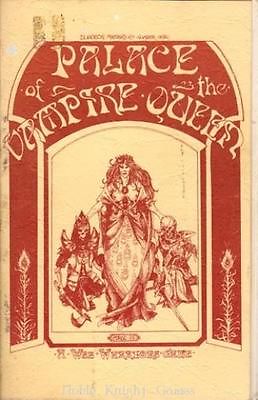 Until this weekend, I’d never heard of the Palace of the Vampire Queen. It was arguably the first official Dungeons & Dragons module ever published… if you consider the Temple of the Frog (from the Blackmoor supplement) to be more of a scenario than a full-fledged adventure module. Here I was thinking Judge’s Guild had the lock on that, but no. A tiny company called Wee Warriors made supplements for the game, which were in turn published by TSR (owners of the D&D license).
Until this weekend, I’d never heard of the Palace of the Vampire Queen. It was arguably the first official Dungeons & Dragons module ever published… if you consider the Temple of the Frog (from the Blackmoor supplement) to be more of a scenario than a full-fledged adventure module. Here I was thinking Judge’s Guild had the lock on that, but no. A tiny company called Wee Warriors made supplements for the game, which were in turn published by TSR (owners of the D&D license).
The module was, in the words of one reviewer, “sketchy.” Your $4.50 got you a stapled booklet with ten maps – five keyed, five unkeyed duplicates – with effectively a spreadsheet of encounters. The spreadsheet had very little information beyond what monsters were encountered and what treasure they held. Dungeon Masters were intended to take the bare bones of the story and the provided encounters and let the players’ story evolve.
Which is actually a pretty cool concept when you think of it. But it might be a bit to ask of less experienced gamers and game-masters, as that’s often the part they need the most help with. Here’s an example of five rooms worth of keyed encounters, taken from RetroRoleplaying.com:
| Room | Creatures Encountered | Max Hits | Contents of Room |
| 1 | 3 Goblins | 4 3 3 | 17 GP on Goblins |
| 2 | none | 6 bags – each bag contains rations for 1 for 1 week in dungeon, but 1 bag is poisoned | |
| 3 | 3 Goblins | 4 4 1 | Armory, 5 swords, 3 shields, 2 daggers. All non-magical. |
| 4 | none | Chest with poison lock, 1,000 CP in chest | |
| 5 | 4 Goblins 2 sleeping, 2 on guard |
5 2 3 3 | Empty. 30 CP, 10 GP on Goblins |
This is slightly more interesting than the results you’d get from running a random dungeon generator like Donjon. But only slightly. And even that’s arguable.
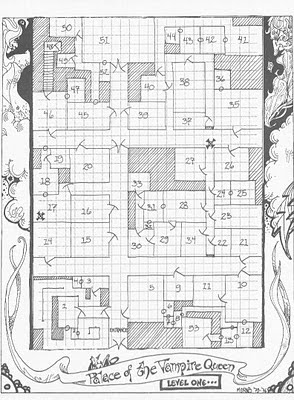 The maps were nicely done, but still resembled the kind of thing anyone would do with graph paper and pencil, with a bit of higher-quality embellishment. But recognize that this was circa 1975, when things were still extremely local, low-tech, and really more of a hobbyist industry than anything else. And really, as far as maps are concerned, a game master really only needs three things:
The maps were nicely done, but still resembled the kind of thing anyone would do with graph paper and pencil, with a bit of higher-quality embellishment. But recognize that this was circa 1975, when things were still extremely local, low-tech, and really more of a hobbyist industry than anything else. And really, as far as maps are concerned, a game master really only needs three things:
- It needs to be clear and easy-to-read
- It should be interesting for the players to navigate and explore
- It should be internally consistent and logical based on whatever laws of reality it is invoking. In other words, no defying major laws of physics or geometry without a cool reason.
- It should actually save the DM some work.
Without actually being able to read through the whole module, I can’t vouch for all of the details, but it sounds good.
So back in 1976, this thing had a cover price of around $4.50. Multiply that by three or so for modern US dollars, and it’s around $15. Yikes. Yeah, I’d expect a little bit more for my money in today’s world.
But as it is a less well-known piece of Role-Playing Game nostalgia, how much would an original copy of this supplement (called a “Dungeon Master’s Kit” at the time) set me back?
A little bit more than its original cover price:
*Coughcoughwheeze* Yeah, I expected it to be outside of my discretionary budget, but this is about 10x my best guess.
There is a more recent reprint and update available that’s a bit more within a curious hobbyist’s price range, but still… Not a bad mark-up. I’m just amazed that it took me this long to learn about it.
UPDATE: D’oh. Demoted the queen to a princess. It was late, and I think I conflated the title with that of another early (TSR-produced) module, Palace of the Silver Princess.
Filed Under: Dice & Paper - Comments: Comments are off for this article
[Archive] Life Lessons Learned Playing Computer RPGs
Posted by Rampant Coyote on September 11, 2015
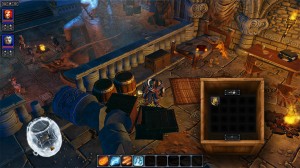 Note: This article originally appeared in 2006. I was playing a lot of Oblivion at the time, but it included many other RPG life lessons. It’s amazing how much you can learn about Real Life from these games…
Note: This article originally appeared in 2006. I was playing a lot of Oblivion at the time, but it included many other RPG life lessons. It’s amazing how much you can learn about Real Life from these games…
#1 – People will use really elaborate locks to protect their pickaxes and yarn
#2 – Strangers met in cities are usually safe. Strangers met out on the road between cities are almost always trying to kill you.
#3 – It doesn’t matter if they are hungry or not – wild animals are ALWAYS aggressive and attack on sight.
#4 – Wild animals also sometimes have pockets in which they carry loose change.
#5 – People really don’t mind repeating themselves endlessly.
#6 – Burials are only for people who died of natural causes. If someone dies due to violence, their body will be left out in the street forever and people will just learn to ignore it.
#7 – The world may be coming to an end, the invading monsters marching in the street, and the town burning around their ears, but merchants will always have time to haggle with you over prices and will always make sure they make a profit.
 #8 – But the merchants are right – you’ve also almost always got time to sleep, have dinner, and run errands in the midst of an immediate apocalypse.
#8 – But the merchants are right – you’ve also almost always got time to sleep, have dinner, and run errands in the midst of an immediate apocalypse.
#9 – Weapons and armor made of soft, precious metals are somehow much stronger than their more boring steel counterparts.
#10 – Perfect strangers will seek you out to ask you to run errands for them.
#11 – Monsters may all look alike, but if one of them has his own unique name, WATCH OUT!
#12 – You may be the best locksmith / lock picker in the universe, capable of facing down villains that can wipe out entire ARMIES – but there will always be some doors that are invulnerable to nuclear blasts and completely impossible to unlock without the correct key.
#13 – Nobody has a problem with you searching through (or even smashing) barrels and crates if they aren’t inside someone’s house (and sometimes even if they are).
#14 – Barrels are great places to store gold coins and suits of armor.
#15 – An enemy can fire an unlimited number of arrows at you in spite of having only five arrows in their quiver. It’s like a pointy, hostile loaves-and-fishes miracle.
#16 – The cashier of any store is willing to buy your pocket-lint from you for half retail price.
Got any more fun lessons you’ve learned? Lets hear ’em!
Filed Under: Geek Life - Comments: 3 Comments to Read
Kickstarter – Mythica 3: The Necromancer
Posted by Rampant Coyote on September 10, 2015
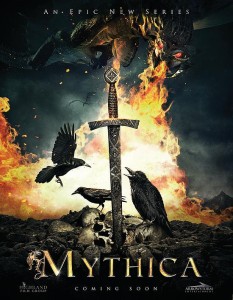 Mythica 3: The Necromancer is crowdfunding on Kickstarter.
Mythica 3: The Necromancer is crowdfunding on Kickstarter.
I understand they’ve already begun building sets for filming the 4th and 5th Mythica movies. I think it’s safe to assume the first two were successful. I liked the first one the best, I think, although I have to admit the effects on the second seemed better. They filmed the first three movies at the same time, but are completing them one at a time with post-production.
I enjoyed the premier screening of Mythica 2: The Darkspore a few months ago at the FilmQuest film festival. We had a good time, and I was happy to support both the movie and the film festival. As low-budget fantasy movies go, these are at the top of the heap in my book. Your mileage may vary, but I saw the third Hobbit movie around the same time as the first Mythica, and I found myself enjoying Mythica more. I’m not sure if that counts as praise for Mythica or criticism of The Hobbit: The Battle of the Five Armies. Maybe a bit of both.
These are movies that I wish had been around when I was a fanatic D&D gaming kid growing up in the 1980s. The best we had back then was Conan the Barbarian and the like. My wife is partial to Hawk the Slayer, which I confess I totally don’t get. These low-budget fantasy movies would have DOMINATED that category back then, but that’s because they actually have something of a three-dimensional plot and characters, and of course special effects and post-processing capabilities that weren’t possible under any budget back in that era. But this is a movie for D&D fans most of all. I mean, you’ve got a party consisting of a fighter, a rogue, a wizard (slash-necromancer), and a cleric, going on these adventures that tie in to a main campaign. And of course, inter-party conflict, etc.
My biggest beef is that they keep saying it “stars” Kevin Sorbo. No, he has only a brief appearance in the first two movies. It’s a little more than a cameo, but he’s definitely not the star. And… as a word of criticism… holy crap, guys, don’t ever film him FAKE riding a horse ever again… That’s probably the worst scene in the second movie. But the film’s real stars – Melanie Stone, Adam Johnson, Jake Stormoen, and Nicola Posener – do a pretty decent job throughout. I know they have to do a crap-ton against a green screen, and some actors don’t do a very good job selling it, but they do. And of course, being in Utah, I dig all the location shots 🙂
Kickstarter is not supposed to be treated as a pre-order or anything, but… yeah, this is pretty much a pre-order. Get bennies & stuff. The film is getting finished regardless, but I’d just as soon make sure they are able to stretch their post-production budget as much as possible. I think the risk factor is extremely low as far as actually getting something in a few months. Whether or not you’ll like it is another story. Personally, I really look forward to seeing the third in the series!
So I’m happy to be a backer. And I LOVE the trailer – it is the best trailer of the three so far, I think. Definitely showing the “team” has leveled up. If you are interested, you can back the project at the KS page:
Kickstarter: Mythica 3 The Necromancer Starring Kevin Sorbo
If you haven’t seen any of them, there are levels where you can get HD downloads, DVDs, or Blu-Rays of all three movies (signed by the cast). You can also check out the first movie at ConTV, and all are available at the Arrowstorm Site for purchase or rent.
Filed Under: Movies - Comments: 3 Comments to Read
The Indie Apocalypse is nigh!
Posted by Rampant Coyote on September 9, 2015
A few years ago, it looked like selling online was excellent. People were getting rich. Companies swelled from just a couple of guys in their basement to dozens or even hundreds of people. But now everything’s falling apart. Clearly, the whole thing isn’t working out. There isn’t enough room, the market got saturated, and if you are just coming to the party now, it’s too late. Good thing you missed the bloodshed. But now things can finally get back to normal, right?
 The above paragraph was pretty much what I heard circa 2001-2003, regarding the “Dot-Com boom.” Substitute gaming for just selling anything online, and … well, that was the attitude. Major business leaders of the “old school” breathed a collective sigh of relief that the whole online thing had been a fad, and things would be back to normal within a few months, and all the laid-off IT workers from the boom days could no longer command gigantic salaries and make their companies beholden to them.
The above paragraph was pretty much what I heard circa 2001-2003, regarding the “Dot-Com boom.” Substitute gaming for just selling anything online, and … well, that was the attitude. Major business leaders of the “old school” breathed a collective sigh of relief that the whole online thing had been a fad, and things would be back to normal within a few months, and all the laid-off IT workers from the boom days could no longer command gigantic salaries and make their companies beholden to them.
My opinion at the time – which I shared any chance I got – was that the dot-com boom and subsequent “bust” was simply a case of trying to pour fifty gallons into a twenty-gallon bucket. Supply had increased tremendously faster than the growth in demand, overshot, and was now coming back to earth. And while those who dumped tons of cash into that growth were going to fall to the wayside, unless they were in the top five or ten percent. But those with a more careful, measured approach that was focused on providing value rather than cashing in on a trend would be fine.
Ya know what? In a general case, I think I was right.
Now the talk lately is about the “indiepocalypse.” The mobile markets are far beyond saturation, and now that’s happening to Steam, too. The hardest hit are the ones who enjoyed the most success when Steam was still all about curation by a tiny number of overworked individuals who couldn’t keep up with the releases already.
And now the bubble is bursting. Oh, noes!
I’ve seen this many times before. I’ve talked about it many times before. Half the folks freaking out about it weren’t even in this industry the last time we had a major indie bubble burst (in the casual games arena). Indeed, it seems that about half the commentary on the “indiepocalypse” has been more mocking it, or planning for survival.
One approach is, of course, to turn indie game development into bigger-budget, winner-take-all mentality, or “Triple-I” gaming. To this, I say, “It’s been done, it’s been happening for decades.” I mean, back when I started, that pretty much WAS Triple-A game development with a big team. And afterwards? That was… um… non-Triple-A mainstream game development. There’s nothing new there. The only thing remotely interesting is that they’ve been able to bill themselves as “indie.” I call them “big indies” and they’ve got the same problem as everybody else, from the massive publishing houses down to the lone-wolf developers: they have to make a reasonable return on their investment, or it’s curtains for them. And since many of them are asking for only a fraction of their budget on Kickstarter, it’s not like they have unlimited funds.
And burn rates are a very real thing in commercial development, even for successful kickstarter-funded games like Thimbleweed Park.
So anyway…. the indie apocalypse. Great bubble-bursting. The end of the indie fad. Whatever. Yeah, it’s real, it’s happening, brace for frickin’ impact. The suckage has already started, and it’s gonna get worse. Probably much worse, if history is a guide. And then it’s gonna get better. But not like “peak indie.” More like a leveling out and a return to more sane levels of growth. The rules will change for the 9,000th time, but the fundamentals will stay the same.
And people are gonna keep making, buying, and playing games.
Then again, what should I know? I was stupid and lame enough not to be able to cash in on the gravy years YET AGAIN, so what would I know about surviving yet another crash? I still treat these things as a spectator sport.
Anyway, for a couple more bits of opinion on the coming indiepoxyklipse or whatever, here are some good reads:
The Rat Race to the Steam Store
Ryan Clark: Five Myths of the Indiepocalypse
Filed Under: Biz - Comments: 4 Comments to Read
Enlisting the Aid of the Genius 14-Year-Old
Posted by Rampant Coyote on September 8, 2015
I joke that I was the world’s greatest game designer right up until the moment I had to design games for a real audience, and then I sucked all of the sudden. Mysterious thing that…
Obviously, the point is that things always look a lot simpler from a distance than once you have to go down into the weeds. But there’s something to be said for that fervor and enthusiasm and complete disregard for boundaries and limitations from someone who is completely ignorant that those boundaries and limitations even exist.
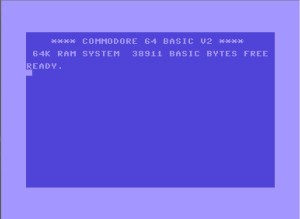 For me, that’s my 14-year-old self. That kid didn’t have a clue, but boy was he excited about gaming. Both the dice-and-paper kind and the video gaming kind. Arcades, D&D, computer games, Atari. And programming! The kid was learning to program, with a shiny Commodore 64 which had a whopping 64k of memory (about 48k of it was usable RAM for programs), and man… things were awesome.
For me, that’s my 14-year-old self. That kid didn’t have a clue, but boy was he excited about gaming. Both the dice-and-paper kind and the video gaming kind. Arcades, D&D, computer games, Atari. And programming! The kid was learning to program, with a shiny Commodore 64 which had a whopping 64k of memory (about 48k of it was usable RAM for programs), and man… things were awesome.
A lot of it came from having a lot of free time and this stuff was a primary diversion for him. I mean, me. I’d get home at some incredibly early hour in the afternoon… and while there might have been homework, I still had several hours to kill. And I often killed them on my computer, or in the depths of D&D manuals. Anyway, the ideas would flow, maps would get drawn, the first part of games would get written (I’d rarely “finish” anything). But there was a raw creativity born of enthusiasm and a lack of experience. A lack of being jaded, to some degree.
I still like to harness that. It’s like a brainstorm… most of the ideas will suck, but the point is to not pre-filter so that you can enjoy a more pure creative flow. The 14-year-old me had a whole ton of ideas and no pressure whatsoever. If he’s still in me, I want to take advantage of that. Channel that crazy, wild-eyed enthusiasm without constraint. Then mix it with the capabilities of the modern world, with far more powerful machines and tools than my 14-year-old self could imagine.
Of course, it’s not really just about remembering what it’s about to see the world through more innocent eyes, and remember what it was like when video games were the most amazing things EVER and how could any mortal being actually make something like that and Dungeons & Dragons was one of mankind’s greatest inventions (along with air conditioning and, of course, video games) and George Lucas could do no wrong. While it’s a fond recollection, I’ve heard lots of 14-year-olds since then, and I wouldn’t exactly want any of them on my design team. My younger self included, I’m sure.
The real point is trying to “program” myself to get “in the zone” quickly on the creative level the same way I get in the zone as a programmer. And there’s no question that those are two radically different zones, at least for me. It’s hard enough to get into one, let alone jump between the two. Shifting those gears doesn’t come easy for me. Yet.
(No, not that zone…)
That creative zone isn’t as easy to come by today as it was when I was 14. These days, that visit by “the muse” feels a bit like being under a tight deadline. In fact, that’s exactly what it usually is. But I know it can be cultivated. I’ve done it before, although sometimes it takes days of encouraging the subconscious to get there. And for very specific ideas, that may be the requirement. But as a general rule, just getting into ‘the zone’ it shouldn’t have to.
Anyway – I’m working on it (again). Some tricks I’m trying include cutting off the distractions (including hitting up the web for “research” which turns into …. something else), kind of an enforced boredom, sense memory (primarily music, some visual stimulus), self-imposed deadlines, and a little bit of reminding myself of what it was like to be a kid again. One day I’d like to be able to answer the question, “Where do your ideas come from?” with a more clear-cut process.
Filed Under: General - Comments: 4 Comments to Read
Utah Indie Scene Gets Some Press
Posted by Rampant Coyote on September 7, 2015
The Utah Indie Scene has received some extra attention lately, due in no small amount to the efforts of a few developers who have gone the extra mile. While they’ve had their own projects they’ve focused a good deal of attention on, they have also worked to put together support networks for indie game developers to everyone’s mutual benefit.
This week (or really, over the weekend), the Salt Lake Tribune published an article about the growth of the local “scene.” There are a few errors in there (Sorry about the name, Greg Squire…), but overall it’s an excellent article.
Upping Utah’s Indie Gaming Scene
Filed Under: Indie Evangelism - Comments: Comments are off for this article
Coming Soon: Beyond the Wail
Posted by Rampant Coyote on September 5, 2015
I mentioned some time ago that I am in a new, upcoming anthology. This is it. Next month Xchyler Publishing releases a new anthology of paranormal tales called “Beyond the Wail.” Here’s a trailer video:
It includes twelve tales of “love, loss, and lamentation.” A lot of them deal with the loss of a loved one. Mine? The loss of an expensive laptop computer, which is almost the same thing. Well, okay, not quite. (And no, that’s not all it’s about either, but that’s my joke…)
Actually, it works best if Rod Serling does the introduction to my story. Do you have Serling’s voice in your head? Good. Here goes:
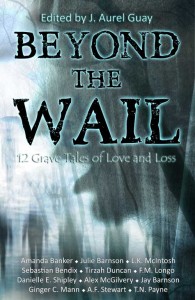 “Our hero for the evening is one Mike Bradshaw, an entrepreneurial security consultant whose calling is to solve mysteries and prevent problems. But tonight, he has a problem encased within an impossible mystery: a machine has been stolen from within a locked room, practically under his very nose. There are no witnesses, no suspects, and no leads… only an empty room, a skilled partner, and some high-tech tools of his trade. What he will soon discover is that his stolen properly lay hidden not within some terrestrial vault, but that both it and the thief can only be found in the Twili…. er, I mean, Beyond the Wail.”
“Our hero for the evening is one Mike Bradshaw, an entrepreneurial security consultant whose calling is to solve mysteries and prevent problems. But tonight, he has a problem encased within an impossible mystery: a machine has been stolen from within a locked room, practically under his very nose. There are no witnesses, no suspects, and no leads… only an empty room, a skilled partner, and some high-tech tools of his trade. What he will soon discover is that his stolen properly lay hidden not within some terrestrial vault, but that both it and the thief can only be found in the Twili…. er, I mean, Beyond the Wail.”
Sound cool? I hope so. You’ll be able to read it and eleven other stories by my fellow authors (including my wife, who weaves a wonderful tail of a mysterious fiddle that can play music that the dead can hear…) in just a few weeks.
Filed Under: Books - Comments: Comments are off for this article
Shattered
Posted by Rampant Coyote on September 4, 2015
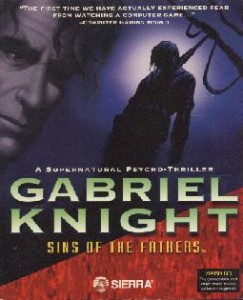 I returned home the other night to find half of an old CD-ROM sitting on the table. It was an original disc for Gabriel Knight: Sins of the Fathers. It was later explained to me that it had fallen off the shelf and out of the jewel case, and our puppy, Clara (yes, named after the Doctor’s companion), got to it. Fortunately, she wasn’t hurt when she shattered it.
I returned home the other night to find half of an old CD-ROM sitting on the table. It was an original disc for Gabriel Knight: Sins of the Fathers. It was later explained to me that it had fallen off the shelf and out of the jewel case, and our puppy, Clara (yes, named after the Doctor’s companion), got to it. Fortunately, she wasn’t hurt when she shattered it.
Once upon a time, seeing that would have been a little devastating. Those discs are long out of manufacturing, so replacing it would have been challenging. And that’s a classic adventure game that I don’t ever want to lose.
Fortunately, I have both a digital copy in an account, and the recent 20th Anniversary remake. So while the loss of the physical media was disappointing, it wasn’t nearly as painful to my game-collecting soul as it would have been. I guess that means that I’ve finally been able to divorce the bits from the atoms in my mind, and I no longer think of games as having any relation to the media they are stored on. I guess that makes sense – thanks to numerous sales and bundles, my ‘game collection’ these days is pretty staggering, and the purely digital copies dwarf my once-impressive collection of physical packaging.
In fact, the last physical copy of a game I’ve picked up was a collector’s edition box for Wasteland 2 that I received as a reward for being a backer. And it was slightly damaged with a puncture on arrival. So much for keeping it in pristine condition!
I still like my old physical packaging. Some of it, anyway. It’s probably nostalgia as much as anything… the packaging was anticipation, a promise. Browsing the shelves, looking at the screenshots on the packaging. Picking up the game during my lunch break and staring at the package all afternoon until I could take it home and play it. After that, the boxes collected dust, and I GREATLY prefer not having to hunt down the CD-ROM (or the key) in order to play the game anymore.
I was never going to need that CD ever again. I still have the jewel case. But more importantly, I still have the game. That’s the important part.
Filed Under: Retro, Tech - Comments: 11 Comments to Read
Of UDEN, the VOID, and the Coffee House Six
Posted by Rampant Coyote on September 3, 2015
 Last night’s UDEN (Utah Digital Entertainment Network) meeting was held at a place called “Church and State,” a non-profit “business incubator” that offers office space to small businesses inside what was once a historic church building build in the 1890s. As the last time I attended, it was a very entrepreneurial-focused meeting consisting of announcements, a keynote address, several three minute “Hive Ignite” talks introducing some of the people involved in the various digital & entertainment industries in the state, and then a networking session until they kicked us out of the building.
Last night’s UDEN (Utah Digital Entertainment Network) meeting was held at a place called “Church and State,” a non-profit “business incubator” that offers office space to small businesses inside what was once a historic church building build in the 1890s. As the last time I attended, it was a very entrepreneurial-focused meeting consisting of announcements, a keynote address, several three minute “Hive Ignite” talks introducing some of the people involved in the various digital & entertainment industries in the state, and then a networking session until they kicked us out of the building.
The keynote was presented by founders of The Void, which was pretty dang exciting on its own. I’m still cautiously optimistic, although as one of the local indie game developers mentioned later that evening, their spiel sounded a bit like an “excite potential investors and get more funding” kind of thing. Having come from a background in electronics, he was quite skeptical of their plans, but I was a little more optimistic, taking the assumption that this was their grand vision, but their actual release will have to be more of a “stage one” compromise. But we’ll see. During one discussion I mentioned their (temporarily) “back-burnered” theme park and accidentally referred to it as “Nevermore” instead of “Evermore.” Nice Freudian slip.
What they presented was pretty incredible (granted, both meanings of the word). But if they can pull this off, they’ll be breaking ground on the first of their VOID Entertainment Centers (VECs) in October, and will be ready for audiences next summer. They’re using a combination of hot new technology – which can be more powerful than normal consumer-level products because they don’t have to fit them in the consumer price range – and plain ol’ fashioned stage magic. Curtis Hickman, the head of content development, is among other things a professional magician. They have some practical effects designed to “argue for veracity” and trick the mind into buying into the illusion presented by the goggles, headset, and haptic feedback. The plan is for the centers to have 8 “stages” each (on two floors) about 60 feet in diameter each, with somewhat fixed physical “sets” (walls and practical effects) that can be disguised through VR to be a cave in one experience, and an alien space ship in another, etc.
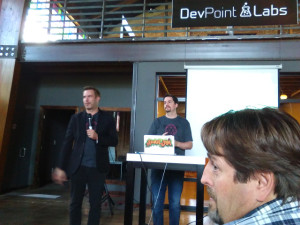 The experiences are intended to be 20 minutes long (although they also used 30 minutes… maybe 10 minutes of preparation & debriefing?), with experiences optimized for 6-8 people at a time. So at peak capacity, they’ll be pushing a little under 200 people per hour through the stages.
The experiences are intended to be 20 minutes long (although they also used 30 minutes… maybe 10 minutes of preparation & debriefing?), with experiences optimized for 6-8 people at a time. So at peak capacity, they’ll be pushing a little under 200 people per hour through the stages.
Some further-off plans include having actors for more interactive content, and motion-based two-person “simulation pods” for another kind of VR. Their plans include mixing up the sim pods with the experiences in the main stages. They mentioned the possibility of a “mecha battle” with some players piloting giant robots through the virtual battlefield while others – on the stage – stayed on the ground as infantry or something.
There were some interesting discussions about how to handle traditional gameplay elements in their events. Traditional videogaming seems like a natural fit, but in practice may not work so well in their virtual worlds. Things like HUDs, respawning, and “ghosting” of other players didn’t work quite so well, and safety (not to mention preventing equipment damage) is paramount. They mentioned trying to change distances so one step was actually 3x the distance traversed to make things seem bigger / faster, and they said it worked out pretty well.
They are planning on centers throughout the world, with new content every quarter, and intend to even work with indies on providing content. And they plan on keeping their headquarters here in Utah.
I want to believe. I’ve read and talked to enough people who’ve tried it out who have verified that this stuff all works really, really well at the prototype stage and they’ve felt it has huge potential. So… maybe. I’m crossing my fingers.
The Hive Ignite addresses were given by representatives from Utah GOED (Governor’s Office of Economic Development,), Spy Hop, MURA Interactive, and Schaffer Studios – a nice cross section of government, nonprofit, game development, and film development. I’m sure that mix was deliberate.
Finally, there was the meet & greet. I got to talk a little more with Curtis Hickman about The VOID’s plans, AJ Dimick from the University of Utah Entertainment Arts & Engineering program, and several others. That’s the fun and weird part of this – tons of discussions, introductions, and ideas going around the room at high-speed and it was different for everyone.
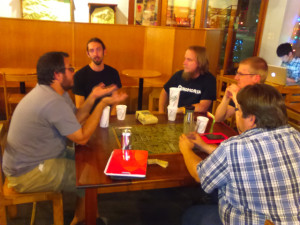 Towards the end, six of us indie game devs got into a fun discussion that we didn’t want to stop even when they kicked us out of the building at the end of the night. So we found a coffee shop across the street that was open for another couple of hours, and just continued talking and swapping war stories there.
Towards the end, six of us indie game devs got into a fun discussion that we didn’t want to stop even when they kicked us out of the building at the end of the night. So we found a coffee shop across the street that was open for another couple of hours, and just continued talking and swapping war stories there.
Then when THAT closed, we ended up taking the discussion outside onto the sidewalk for another 45 minutes. I watched four police cars go by us and turn near us during the time. Actually, I’m not entirely positive it wasn’t the same one. Six geeks WELL out of our teens hanging out on a street corner in downtown Salt Lake City in the middle of the night? Yeah, we’re trouble. I’m sure they were just looking out for our safety.
And people say we introvert gamer types don’t like to be social. BULL. We just need the right type of social interactions and then we have trouble shutting up. (Although I really don’t consider myself that much of an introvert…)
All-in-all… I had a blast. I left energized, excited, and really thinking about what I can do to push Rampant Games to the next level. So it was a pretty productive night, too.
Filed Under: Events - Comments: 2 Comments to Read
